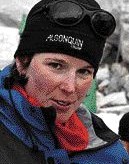Shaunna Burke reaches Everest summit
Ottawa’s Shaunna Burke reached the summit of Mount Everest late last night, becoming the second Canadian woman in history to reach the top of the mountain.
“It took quite awhile,” said Ms. Burke’s former climbing partner, Ben Webster. “Shaunna was in the first couple of climbers to reach the summit.” Ms. Burke’s climbing group was the first to succeed the climb from the south side this year.
Peggy Foster, on the opposite side of the mountain, decided to wait for better weather.
Ms. Burke and three Sherpa guides left Camp Four for the gruelling 10- to 16-hour oxygen-assisted climb to the summit at 10 p.m. local time. If the climbers had started at dawn, they would arrive at about 8 p.m. and would have to return exhausted in the dark with their oxygen and other supplies running out.
“They would be coming back in the dark when it is much colder if they started early in the day,” said Mr. Webster, who has been monitoring Ms. Burke’s climb from Ottawa since breaking a leg on the mountain. “The plan was to start in the darkness so they could get home.
“If you don’t make it back to your tent by the evening of your summit day, you are caught out on the mountain and there is probably a 99-per-cent chance that you are not coming home at all. If you don’t make it back to your tent, you are dead.”
Above the camp, the group entered the “death zone,” where the body can no longer acclimatize on its own.
When climbers are above 7,000 metres, they enter an area where the body starts to die at an accelerated pace, Mr. Webster said.
Ms. Burke could die from any number of things, he said, including cerebral and pulmonary edema, the accumulation of fluid on the brain or in the lungs.
“They are very close to the jet stream so weather patterns can change very quickly and climbers can suffer from frostbite and hypothermia.
“She has not slept for three days and has had very little food because the body does not process food at that altitude. They have to break the trail and set the safety lines to allow them to climb through the technical areas.”
Sometimes, the oxygen tank valves can freeze causing climbers to have difficulty because of a lack of oxygen.
Heavy winds, snow and extreme cold have all but shut down the 8,848-metre mountain in recent weeks, allowing only a handful of climbers to reach the top this year. All have come from the north side.
Last Thursday, Ms. Burke made her way up through the Khumbu Icefall one last time to settle into Camp Two. On Saturday, she reached the 7,200-metre high Camp Three.
Her group climbed to Camp Four at 8,000 metres on Saturday night.
Ms. Burke said the Nepalese government was open to extending the June 1 climbing deadline, allowing for a later than usual summit attempt this week.
Late last week, the winds on the south side finally started to subside, opening the possibility of the summit attempt that was looking bleaker by the moment. A year ago, Ms. Burke was forced to abandon her quest at Camp Four — 850 metres from the summit.
Meanwhile, on the north side, Peggy Foster who is at the 6,400-metre level, does not plan to leave the advance base camp for the summit until today or tomorrow. The temperature at the summit yesterday was -23 with winds of more than 30 kilometres an hour.
Ms. Foster’s father, Maurice Foster, said he expects his daughter to reach the summit about June 4 or 5.
“It may go a couple of days earlier or later depending on the winds,” Mr. Foster said.
“If you get into 80-kilometre-an-hour winds with a -25-degree temperature, that is not a good situation to reach the summit. High humidity and snow would make it a lot tougher.”
If she is successful, Ms. Foster will be the first Canadian woman to scale the highest peaks on all seven continents, known as the “seven summits,” having successfully reached the summits of Mount Aconcagua in South America, Mount Elbrus in Russia, Mount Kilimanjaro in Africa, Mount Vinson in Antarctica, Mount McKinley in Alaska and Mount Kosciusko in Australia.
A summit attempt this late in the year marks a fitting end to what has, by all account, been a bizarre climbing season.
“It’s hard to explain,” Ms. Burke said, before leaving base camp for the last time. “There’s not been much luck at all this year.”
She said she had prepared herself emotionally for the prospect of not being able to reach the summit.
“It’s frustrating, but I have no control over it,” she said.
Nonetheless, she had said “there is still a chance.”
Many have already abandoned their bids this year. Ms. Burke, though, had vowed she would stay up there till the bitter end.
“My philosophy is: I’ve been here for so long already — what’s another week?” she said.
She said she has been trying to stay as focused as possible during the long wait at base camp, hiking every other day to stay in shape. Mostly, though, she said she was just trying to stay calm and focused.
An effort that, in the end, paid off for Shaunna Burke.

 Contact aron
Contact aron RSS SUBSCRIBE
RSS SUBSCRIBE ALERT
ALERT